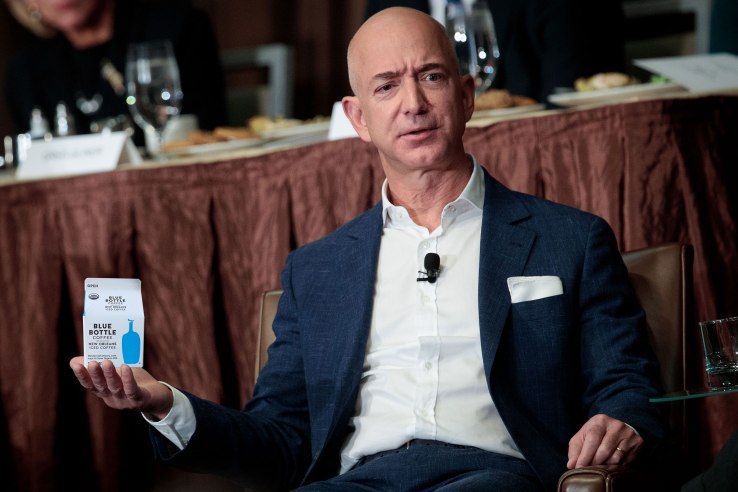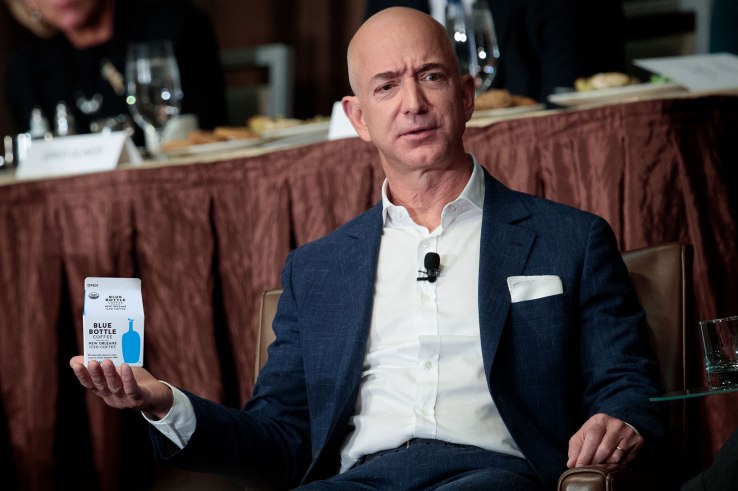

Holy hell, it’s been a year for Amazon. Jeff Bezos’ former-online-bookstore dumped $13.7 billion to buy a bunch of grocery stores, that speaker you talk to in your living room that Amazon makes is really popular and a bunch of server farms Amazon runs generate more than $10 billion in revenue annually.
The confluence of all these things has led to an incredible rise in its stock on the year — one that might be even more impressive than Apple’s slow march toward hitting a $1 trillion market cap (assuming the iPhone X story plays out the way they hope). Amazon is nowhere near as big as Google or Apple, but at the same time, its core business is an online retail operation that operates with razor-thin margins. For the most part, Bezos has gotten the benefit of the doubt from Wall Street, and its strategy of gleefully investing in new operations appears to be playing out as hoped.
Let’s get to the chart:
And with all this, its founder and CEO Jeff Bezos is making a run at becoming the richest human in the Local Group. Amazon is investing in a lot of wild operations, like buying Whole Foods, and all of these big moves are starting to coalesce into something that actually makes a little bit of sense as the company looks to become the backbone of the way people run a lot of their daily lives through the internet. Whether that’s buying stuff online, buying groceries, watching movies, listening to music or even using services that are running on Amazon’s invisible infrastructure, the real Amazon is becoming an absolute force in the everyday life of nearly every internet consumer.
So, because Amazon did all the stuff this year, we’re just gonna run through each one bit by bit, starting off with probably its most important one.
Amazon’s server business is booming
Were it not for AWS, Amazon probably would not have posted a profit in the string of quarters that it did. We’ve noted this before, but here’s the money chart again:
While Amazon is increasingly facing a lot of competition from Microsoft’s Azure, as well as Google Cloud, it was one of the original infrastructure operations that gave birth to modern internet services, helping startups get off the ground with servers that they didn’t have to buy themselves. It was also one of Amazon’s most ambitious bets, and one early example of how Amazon was willing to bulldoze its way into new markets orthogonal to its core business model.
The bet paid off, with AWS now on track to generate more than $10 billion annually. More importantly, that $10 billion annually comes with a pretty healthy margin — though, over time, that margin may slip down. For the time being, though, it’s an impressive business compared to the razor-thin profits that Amazon might generate from its retail operations and a good data point as its media services like video or music start to play out.
And, as usual, recurring revenue is a story that Wall Street loves. Amazon is a company that people will often tell you not to bet against, and its stock is up more than 50 percent on the year thanks to an array of businesses that all appear to be showing growth and the company’s recent-ish ability to turn a profit. Amazon can thank AWS a lot for that.
Amazon’s play for the vocal internet
Amazon also said the Echo, its voice-enabled speaker, was the best-selling product on Amazon for the holiday season, with millions of devices sold. This is a pretty big deal for Amazon, as it may have stepped into one of the single-best new interfaces for the internet as a whole — as well as reducing the friction further for buying stuff on Amazon. And for a service that is essentially the hub of online commerce in the U.S., having an Amazon-sold item is also a pretty good look for the company.
Even if the devices are relatively cheap, locking consumers into the Amazon ecosystem, in the end, is likely much more valuable than selling a bunch of internet-connected speakers. Amazon Prime gives Amazon an opportunity to turn its shoppers from once-in-a-bit purchasers to a reliable stream of recurring incremental revenue. Amazon doesn’t do much in terms of disclosing how Prime performs, but at the same time, a reliable recurring revenue model is something that Wall Street loves — and something that’ll keep them happy and off Bezos’ back.
We’d love to show you a chart here, but the best we’re gonna get is some kind of vague large number from Amazon. So for now, be skeptical, but assume that it’s big and has a lot of potential ramifications for the future of the internet (as much of Amazon’s operations do) — especially as companies like Google and Apple nip at its heels.
Amazon buys a bunch of grocery stores
Amazon made one of the biggest and splashiest acquisitions of the year, second only to Broadcom’s move to acquire Qualcomm and consolidate the fabless semiconductor market into a single unit (which is an equally very large deal). It acquired Whole Foods, a trendy grocery store chain that has a strong brand, for $13.7 billion — and it went through! This was both wildly, in a very Amazon way, expected and unexpected (and was definitely not a good thing for Blue Apron, which was prepping to go public at the time).
Whole Foods gives Amazon a set of local waypoints for groceries, but also storefronts to get its products in front of consumers. It can apply its wealth of data to reorient the prices of products in such a way to get consumers in the door for their staples while getting them interested in other products. And, maybe, more importantly, it can stick its own products in those stores, like the Echo.
While this gives Amazon a big business right away, it also offers Amazon yet another opportunity to lock consumers into the Jeff Bezos Sphere of Influence. We don’t know the full ramifications here just yet, but it’s another example of how Amazon was ready to just crash its way into a new market that sort of makes sense in the Amazon grand scheme of things.
Amazon, in the end, is setting itself up for a future where it serves as the backbone of how consumers interface with products they use in their everyday life that are, in some way, connected to the internet. These moves may seem drastic and have a very long runway to play out, but if you ask a lot of people in tech which stock they would keep from the FAANG group (Facebook, Apple, Amazon, Netflix and Google), you’re probably going to get Amazon as an answer. And then they’ll reference that Tweet wherever that says Amazon grew x thousand percent since it went public (because, in hindsight, I guess we totally should have seen this coming, and the future played out exactly as it was supposed to). So as we head into 2018, we’ll see if Amazon actually fulfills that destiny.
Also, Amazon should buy a coffee shop
Seriously, Jeff, buy a coffee startup. Maybe don’t spend as much as Nestlé did on Blue Bottle. Or do. Whichever. There can only be good things that come of this.
Featured Image: Drew Angerer/Getty Images

